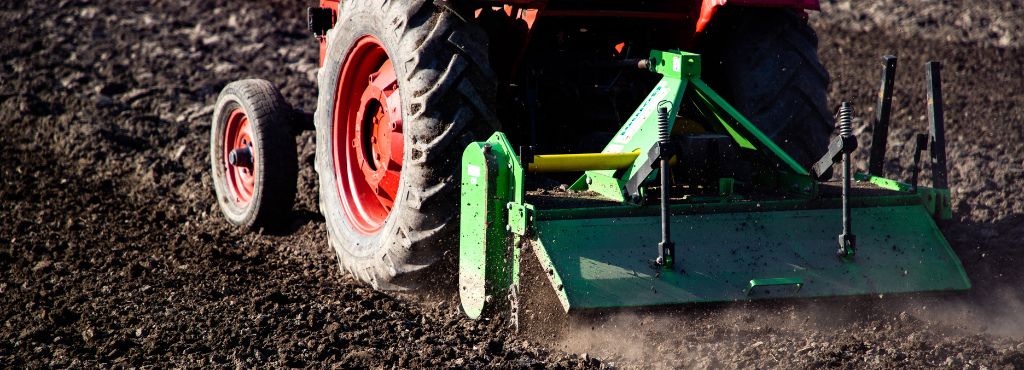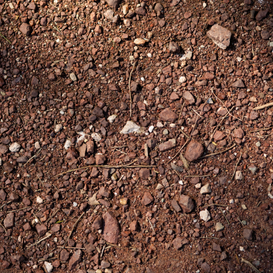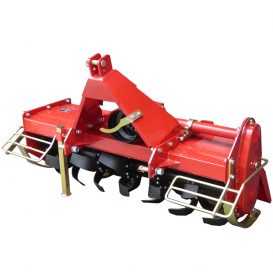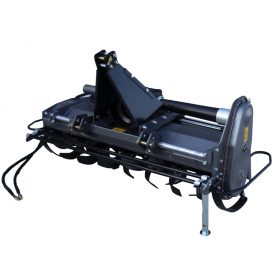The Complete Guide to help you choose the Best Tractor-mounted Rotary Tiller
by the Real Experts of Tractor-towed Agricultural Machinery
CONTENTS
1. Introduction
Tractor-mounted rotary tillers, also known as tillers or rotavators, belong to the category of farm equipment for soil overturning. They mainly serve the purpose of refining the surface layer of the soil, with an average working depth of about 30 cm, to prepare the soil for seeding. They can also be used for eradicating weeds.
A rotary tiller is a machine to be attached to the tractor, therefore there are different versions to meet the specific needs of the various models of tractors and the type of soil to be worked. There are also versions that can be adapted to older tractors with reverse rotation.
When choosing the best rotary tiller, it is important to take into account the ratio between the machine’s sturdiness/series and the tractor’s power, since a tiller that is too undersized is more likely to be damaged. In fact, if a light series tiller is attached to a very powerful tractor, the operator may not notice that the machine is being excessively exerted during work. Conversely, if applied to an underpowered tractor, the rotary tiller will be ineffective.
2. The main components of a tractor-mounted rotary tiller
A rotary tiller consists of a frame to which a gear reducer is attached, and this, through its connection to the tractor’s PTO, puts into motion a rotating shaft (or rotor) where the hoes are mounted. Rotary tillers can also be equipped with an hitch to which other machines, such as seeders or compact rollers, can be connected.
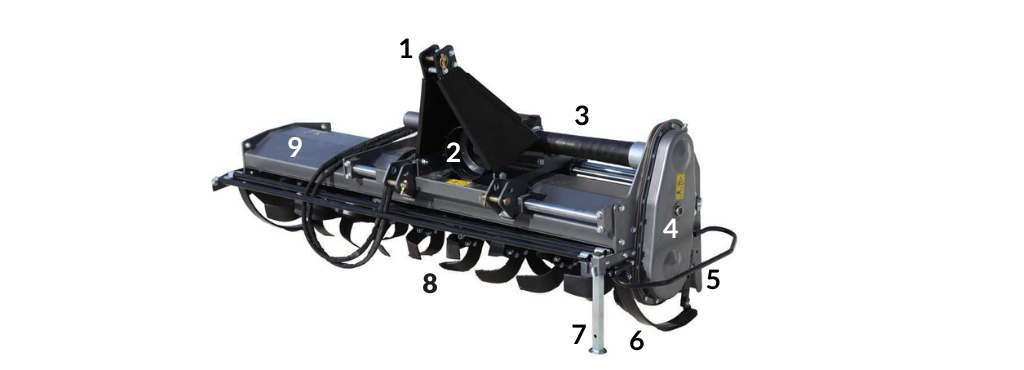
- Three-point hitch (with universal mounting pins to connect to the tractor lifting arm; it can be of different categories depending on the size of the machine)
- Cardan attachment/ Power take-off (it powers the machine by setting the engine rpm)
- Shift (manual, mechanical or hydraulic)
- Side transmission (more or less sturdy, in oil bath)
- Rear trailing board (adjustable by means of a chain to prevent clods from being thrown off at a distance)
- Side support skids (height-adjustable, they allow to set the working depth)
- Parking stand (support foot for storage)
- Hoes (the tools that actually work the soil: they can vary in number and are attached to discs, which in turn are mounted on the rotor. The size, structure and number make all the difference to the final tillage result)
- Frame (in aluminium or cast iron)
3. Soil tillage: milling
Two different types of tillage can be carried out with the rotary tiller:
- preparatory tillage work, which is performed to create the seedbed. In this case, the rotavator can serve as an alternative tool to the plough for mixing and breaking up the soil, even with the presence of crop residues, in order to be able to go straight to the sowing stage without the need for further intervention.
- soil refinement work, which is used to break up clods of soil and level out the surface after initial tillage with the plough. This results in an uniform and levelled working area.
The choice of type of tillage to be carried out with a rotavator also depends on the type of terrain. A rotary tiller is mainly suitable for soils ranging from sandy to clayey, whereas it is less indicated for use on skeletal soils due to the high power absorption of the equipment.

Skeletal soil 
Sandy soil 
Silty soil 
Clayey soil
Indeed, soil can classified according to its texture, i.e. the percentage of mineral particles in it and their size. The textures range from skeletal soil with particles having diameters greater than 2 mm (rock fragments, cobbles, gravel and laterite concretions or ironstones to even large-sized stones), to clayey soils with particles smaller than 2 microns in diameter, the absolute smallest. It is therefore necessary for the rotary tiller to work as much as possible on ”clean” ground, that is, free of stones that could cause both damage to the hoes and, in the worst cases, to the rotor, the frame or the various transmission parts.
The rotavator is also a suitable tool for smaller plots of land such as vegetable patches and gardens, orchards, vineyards and olive groves, as it can be used to improve soil structure by breaking up the surface layer of soil to achieve better water infiltration. Finally, the use of the tiller in the garden enables full mechanical weed control, thus avoiding the use of chemical herbicides.
4. Types
There are various types of rotary tiller, which can be classified based on factors such as sturdiness/series or shift type.
| Sturdiness/series | Shift | Speed change |
|---|---|---|
| Light series | Fixed hitch | Present |
| Medium-light series | Manual shift | Not present |
| Medium | Mechanical shift | |
| Medium-heavy series | Hydraulic shift | |
| Heavy series |
An often underestimated but nevertheless very important feature is lightness. A lightweight tiller is able to perform soil milling more quickly and guarantees excellent results. The ideal solution would be choosing tillers that are both lightweight and powerful enough to work on the most difficult terrain.

Fixed hitch 
Manual shift 
Mechanical shift 
Hydraulic shift
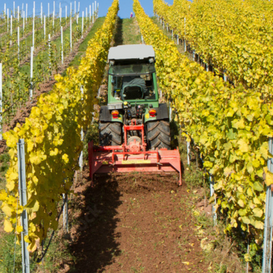
The shift type is an important factor in choosing the best tiller for your needs. The versions with fixed hitch do not feature the possibility of moving sideways to the tractor, so they are more suitable for open field work. Whereas rotary tillers with manual shift system with crank and models equipped with a practical hydraulic shift, to be connected to the tractor’s control unit, can also be used for soil milling work between rows and stumps.
The hydraulic shift system is the most widely used for crops requiring row tillage. The main reason for this lies in the fact that some machine models are equipped with a special sensor that detects when the tiller equipment gets too close to the vine stump and directs it to move sideways. This makes it possible to cover as much area as possible, whilst avoiding harming the plant or, in the worst cases, cutting it off.
Other features that should be taken into account when looking for the best tractor-mounted rotary tiller are:
- the number of hoes: the higher the number of hoes, the better the soil tillage with less strain on the tractor;
- the type of hoes: vertical blades are the best type as they provide greater soil permeability, while tillage perfomed with L-shaped blades results in a more pressed ground bottom;
- the working width: versions ranging from 90 cm to 215 cm can be chosen depending on the amount of soil to be worked and the power of the tractor;
- the gearbox: in cast iron (more durable) or aluminium;
- the side transmission: it can be chain or gear drive, depending on the category of the machine.



